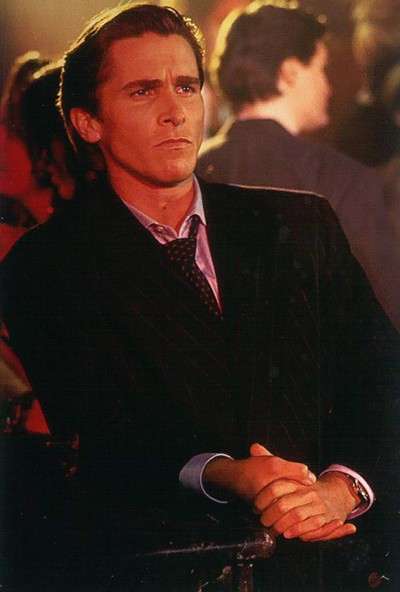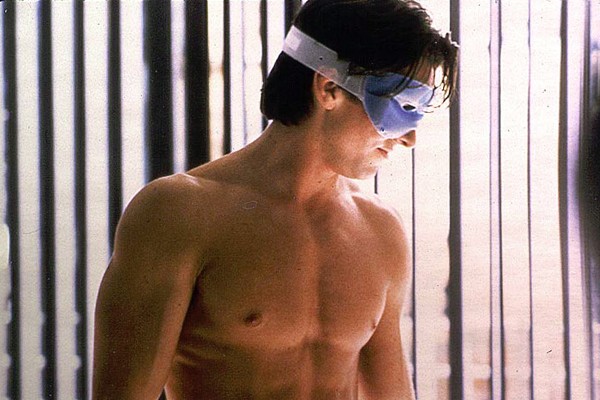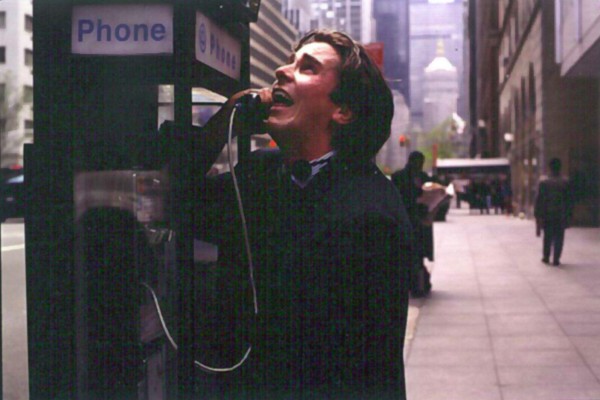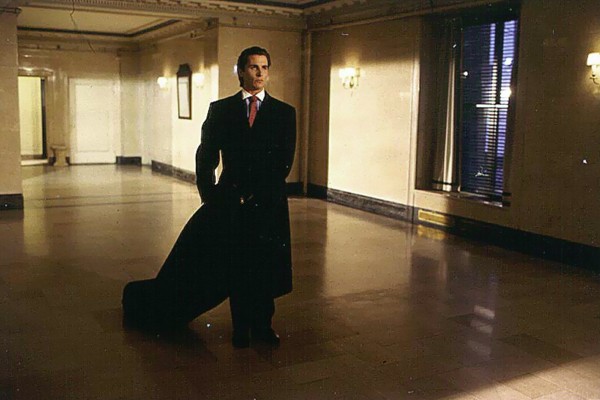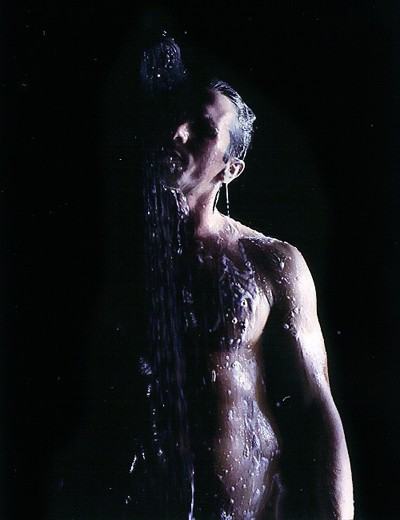

 |
Copyright © Lions Gate Films
 |
American Psycho
"American Psycho is a beautifully controlled, careful, important novel. . . . The novelist's function is to keep a running tag on the progress of the
culture; and he's done it brilliantly. . . . A seminal book." --Fay Weldon, Washington Post
|
About the Book
In American Psycho, Bret Easton Ellis imaginatively explores the
incomprehensible depths of madness and captures the insanity of violence in our
time or any other. Patrick Bateman moves among the young and trendy in 1980s
Manhattan. Young, handsome, and well educated, Bateman earns his fortune on Wall
Street by day while sepnding his nights in ways we cannot begin to fathom.
Expressing his true self through torture and murder, Bateman prefigures an
apocalyptic horror that no society could bear to confront.
"The first novel to come along in years that takes on deep and Dostoyevskian
themes. . . . [Ellis] is showing older authors where the hands have come to on
the clock. . . . He has forced us to look at the intolerable material, and so
few novelists try for that anymore." --Norman Mailer, Vanity Fair
"What's rarely said in all the furor over this novel is that it's a satire, a
hilarious, repulsive, boring, seductive, and deadpan satire. . . . Ellis is,
first and last, a moralist. Under cover of his laconic voice, every word in his
three novels to date springs from grieving outrage at our spiritual condition. .
. . Ambition alone sets it apart from most contemporary fiction. Prudes, squares,
and feminist commissars aside, the rest of us should applaud Bret Easton Ellis
for setting out in this noble and dangerous direction." --Henry Bean, Los
Angeles Times Book Review
About the Author
Bret Easton Ellis is the author of The Informers, Less Than Zero and The Rules of Attraction.
He was born in 1964 and raised in Los Angeles. He is a graduate of Bennington
College and lives in New York City. His latest novel, Glamorama, is now
available in paperback from Vintage Books.
About
the Film Bret Easton Ellis'
"American Psycho" was perhaps the most controversial and hotly-debated novel of
the last decade. Inciting all manner of protests for its graphic violence, its
intensely dark tone made both the book and its author the subject of intense
criticism. But the novel was not without its defenders. Christopher
Lehmann-Haupt of The New York Times noted that "it's as if 'American Psycho' had
returned us to some bygone age when books were still a matter of life and death
instead of something to distract us on a flight between JFK and LAX." And,
Lehmann-Haupt may have best conveyed the essence of the book in his description
of its central character: "Patrick Bateman lives in a morally flat world in
which clothes have more value than skin, objects are worth more than bones, and
the human soul is something to be sought with knives and hatchets and drills."
Few characters have personified an era as disturbingly as Patrick Bateman. In
the same way that FRANKENSTEIN gave us a monster for its time, AMERICAN PSYCHO
gives us a monster for the late 20th century. Showing contemporary urban life
through the eyes of a serial killer--forcing readers to enter his mind and
understand his motives--the book sets forth a vision that is both terrifying
and chilling.
A superbly wrought specimen who has all the accoutrements of a young "master of
the universe," from designer wardrobe to designer pharmaceuticals, Bateman is
seemingly perfect--just like everyone else in his crowd. He desperately wants
to fit in yet, the terrible irony is, the more he tries to be like every other
money-drenched man on Wall Street, the more faceless he becomes--and the less
control he has over the terrible urges that, ironically, make him feel like an
individual. Bateman is a paragon of conformity in an amoral society where to
conform is to be amoral.
But, more than other fictional criminals, the character of Patrick Bateman seemed
to strike a particularly raw cultural nerve. Woven inextricably into his
bloodlust was his lust for things, a kind of material fetishism for well known
brand name, products, and places, that seemed almost as gruesome as his crimes.
Relentlessly, he reminded us of our culture's insatiable greed during the
extraordinary economic boom of the late 1980s. By implicating us into Bateman's
nightmarish world through the very clothes we wore and things we owned, by
linking every trend we followed and every pop icon we worshipped to such a
morally bankrupt murderer, AMERICAN PSYCHO might have struck too close to home--but what a beautifully decorated home it was!
Now, nearly a decade after the book's publication, benefiting from the distance
and sharpened perspective that come with time, "American Psycho's" provocative
social commentary can be re-evaluated and appreciated. Looking back from the
cusp of the new millennium, we realize it operates metaphorically and that its
content is not as emotionally charged nor as literal as it once seemed. It can
finally be confronted--this time in the form of a stunning social satire for
the screen.
Lions Gate Films and Edward R. Pressman Film Corp. present
"American Psycho." Directed by Mary Harron, AMERICAN PSYCHO was adapted
for the screen by Harron and Guinevere Turner based on the novel by Bret Easton
Ellis. The film stars Christian Bale, as Patrick Bateman. Rounding out the
ensemble are Willem Dafoe, Jared Leto, Reese Witherspoon, Samantha Mathis, Chloe
Sevigny, Justin Theroux, Matt Ross, Bill Sage and Cara Seymour. Produced by
Edward Pressman, Chris Hanley and Christian Halsey Solomon, the film is executive
produced by Michael Paseornek, Jeff Sackman and Joe Drake.
* * *
Unfazed by the controversy that AMERICAN PSYCHO stirred up, director/screenwriter
Mary Harron looked past the book's graphic violence and recognized a valid vision
of our culture. She also saw that the intervening years would allow a new
perspective on the material. When both the era and the book are viewed from the
distance of nearly a decade, she explains, AMERICAN PSYCHO comes into focus as "a
brilliant social satire and a devastating portrait of the 1980s. The book
captures the insanity of that period like nothing else."
In the hands of Harron and co-writer Guinevere Turner, the story was transformed
into a screenplay that Harron describes as "a kind of fable rather than a
realistic drama, because on a literal level, Bateman would never have gotten away
with it. But that is precisely the point of the novel--and the film--that
might have become lost in the controversy. The fact is, no one suspects Bateman
of being a monster because his externals fit so perfectly into his social
landscape. 'AMERICAN PSYCHO' is not a 'message' movie--we're not preaching--but I hope that the film does reveal something about our society," Harron says.
The result is a scathing, almost Swiftian social commentary that uses a
particularly compelling criminal as a barometer for his times. On screen, Bale's
Bateman has such disparate and disturbing antecedents as the creepiness that
Peter Lorre pathetic compulsive killer in Fritz Lang's classic, "M," the stylish
and superficially charming Joseph Cotton in Hitchcock's SHADOW OF A DOUBT, and
the gleefully amoral Malcolm McDowell in Kubrick's A CLOCKWORK ORANGE.
And, even though AMERICAN PSYCHO is presented as a period piece, albeit a
not-too-distant past, it has contemporary resonance and, like its predecessors,
it aspires to timelessness. "When I first thought about doing the movie, I was
looking at it as a period piece," Harron notes, "because in 1996 we were looking
back at an era that I thought was long gone. As it turns out, today's stock
market is wilder than ever, and people are once again obsessed with consumption.
It's just less shameless than it was ten years ago. Everything in the 80s was
over the top Ð think about Christian Lacroix and the fact that 'beggars purses'
filled with caviar appeared on menus. Today the money is back, and while the
spending is a little less flagrant than it was ten years ago, people seem just as
unconcerned with the plight of those less fortunate."
While the book's notoriety sprang from its depictions of violence, the film has
taken a different tack. To draw out the tale's satirical essence, Harron and
Turner pared down the original story and selected pivotal moments, capitalizing
on the humor in characters' behavior and retaining key elements of Ellis'
"brilliant and very funny dialogue," says Turner. In addition, most of the
violence takes place off-screen. "We knew from the start," Turner continues,
"that if done incorrectly, this screenplay could translate into an exploitative
slasher film. That was the last thing we wanted. Instead, what isn't seen is
far more terrifying." Harron's production designer Gideon Ponte calls their
philosophy "a form of 'less is more.' The approach is minimalist, relying on a
few creepy details here and there. Then it's up to viewers to use their
imaginations and fill in what happened."
Copyright
© 1999, Random House, Inc
Photos Copyright © 1999, Universal Studios.
